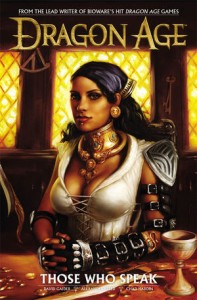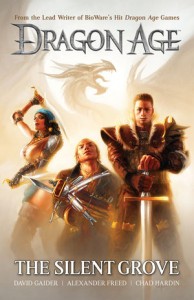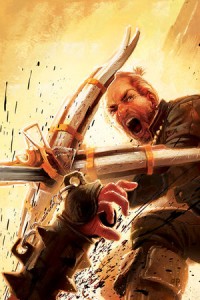
In March, the first issue of Dragon Age: Until We Speak will be published by Dark Horse Comics. Until We Speak is the final part of the trilogy that David Gaider and I have been working on since Dragon Age: The Silent Grove began in February of 2012; the trilogy tells a story set in the Dragon Age video game universe revolving around the familiar game characters of King Alistair Theirin, Varric Tethras, and Isabela the pirate. Dragon Age: Those Who Speak–the second part of the trilogy–has just been collected in a lovely hardcover edition.
That being the case, I thought now was a good time to talk about how we put the story for these comics together. All three series have been a collaboration between myself and David Gaider, Lead Writer for the Dragon Age video games (and author of several Dragon Age novels). It’s been different than my usual work and an intriguing challenge…
Each series follows roughly the same process: David Gaider starts with some key points of the story he wants to tell and sends them to myself and Dave Marshall, our editor at Dark Horse. At this stage, my job is just to pay attention, flag anything that strikes me as potentially tricky, and maybe suggest a few minor items I’d like to see included. David is the vision-holder for the comic, so I want to stay out of his way so he can do what he’s best at.
Next, David puts together a detailed plot synopsis, breaking things down issue-by-issue and scene-by-scene, even including portions of dialogue. Once again, this comes to Dave Marshall and myself, and we both take our red pens and start giving detailed feedback. I do my best to approach this part with an editorial mindset–not asking “What’s the story I most want to tell?” but rather, “What’s the best way to tell this story?”

At this point, I’ll also start making notes on how to translate the synopsis into a comic–estimating how many pages a given scene might take and adjusting the pacing accordingly, checking to make sure that every scene is going to be visually interesting for the reader (and for Chad Hardin, our artist!), deciding what “layering” of narrative captions, dialogue, and art will best convey the tone of an issue, and so forth.
Once David Gaider provides the final version of the synopsis and I’ve finished making my notes, I start scripting–breaking everything down into page by page, panel by panel descriptions, writing out every line of dialogue, and so on. I do so knowing that my job is to find the absolute best way to express David’s story from the synopsis in comic form–but if I see a way that diverging from the plan will improve the story as a whole, I’ll either ask David for his thoughts or just go ahead and make the change. After all, there’s still one more step…
…and that’s when my script goes to David Gaider and Dave Marshall, who both have a chance to give their feedback. In particular, David can make sure that everything is true to the Dragon Age lore and that all the dialogue suits the established characters–as well as offering any general suggestions that might be useful! Once I resolve any outstanding issues in the revised draft, it’s on to Chad Hardin for art and then (after coloring, lettering, and several other vital steps) to the printer.
That’s about it–but I didn’t want to upload this post without giving David a chance to give his perspective. I asked him to take a glance at my writeup and see if he had anything to add from his side, and he kindly sent the following:
I think the thing I was most surprised by was how hard it is to condense your story into a set number of pages. In a game, there’s always room to extend the scene or write some more words. In a novel, there’s always room to expand the number of pages. Yes, you can’t go overboard, but you’re looking at the big picture rather than saying things like “this chapter can only be 12 pages and you’ve written 14.” So thankfully Alex had way more experience on how to pace a comic, as naturally my first impulses were to write something that would require a lot more talking and far too many scenes. You get better at it, but this process made it far less painful than if I’d tried it on my own… and as is typical for me, I thought the collaboration had some nice results. Alex often thought of ways to have a scene play out (Isabela’s flashbacks in “Those Who Speak” are a good example) which I’m pretty certain I’d never have thought possible.
 I should emphasize that David was always more than willing to make accommodations when the medium demanded it–it’s always difficult to see someone else take hold of your work, but he was game all the way through.
I should emphasize that David was always more than willing to make accommodations when the medium demanded it–it’s always difficult to see someone else take hold of your work, but he was game all the way through.
The end result, I think, is a David Gaider story filtered through an Alexander Freed lens–not quite what either of us would have done alone, and hopefully unique and stronger because of it! That’s not even addressing the role the artist has to play, which is pivotal for any comic book (and a different essay on collaboration); Chad Hardin has done wonderful things to translate and expand what’s given him onto the page.
If we do our jobs, you get an engaging and thoughtful adventure fantasy and a solid addition to the Dragon Age universe. If that sounds interesting, give it a shot. And let us know what you think!
Dragon Age: Until We Sleep #1 will be in comic shops on March 27th. A preview is available here. Dragon Age: The Silent Grove and Dragon Age: Those Who Speak are available now in hardcover and digital formats.
All images in this post come from DarkHorse.com and are used without permission.
